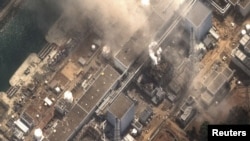Citing “research by Armenian and foreign scientists,” the head of the Armenian State Committee on Nuclear Safety Regulation, Ashot Martirosian, said a magnitude 8.9 earthquake, which has wreaked havoc on Japan, is highly unlikely to hit the mountainous country.
Martirosian also argued that the reactor cooling system of the nuclear plant at Metsamor is different from that of the Fukushima Daiichi facility.
The Japanese authorities have blamed the failure of the cooling system for explosions at two Fukushima reactors in the aftermath of the devastating March 11 earthquake and tsunami. Diesel-powered emergency backup generators, which are meant to keep the reactor cores cool during an emergency shutdown, were flooded and knocked out by the tsunami.
The Fukushima plant has six reactors that were built in the late 1960s and the 1970s. Metsamor’s two reactors went on stream in 1976 and 1980.
Citing security concerns, the Soviet government decided to shut them down one year after the powerful 1988 earthquake that killed some 25,000 people and devastated much of northwestern Armenia. The plant is located 75 kilometers from the epicenter of the quake.
Metsamor’s second reactor was reactivated in 1995 to end a severe energy crisis that crippled Armenia in the early and mid-1990s. The then Armenian government made the decision despite objections from the United States and the European Union.
The latter classified the plant’s VVER 440-V230 light-water reactor as one of the “oldest and least reliable” of 66 such facilities built in the former Soviet Union and Eastern Europe. Both the EU and the U.S. have spent tens of millions of dollars to finance significant safety improvements at Metsamor since 1995.
In an interview with RFE/RL’s Armenian service, Martirosian insisted that the Metsamor plant is now reliable enough to withstand a powerful earthquake similar to the 1988 calamity. He also claimed that its cooling system is more reliable than Fukushima’s.
“The Metsamor reactor is cooled by a second contour, which is a separate system, a separate barrier,” said the official. “Theoretically, such an emergency situation can not arise here.”
But Suren Azatian, Metsamor’s former director general, cautioned that the plant close to Yerevan is “not that protected” against radioactive leaks. He argued that unlike Metsamor, Fukushima has concrete containment vessels around its reactors that appear to have not been breached after the tsunami.
Even so, Azatian asserted that Armenia should continue to heavily rely on atomic energy. “After [the 1986 accident at the nuclear plant in] Chernobyl, all safety standards here were radically toughened,” he told RFE/RL’s Armenian service. “They will again be revised after the Japanese emergency. In case of implementing them, we can build and exploit [nuclear plants] without problems.”
“One must not panic and say that this is a terrible technology that must be abandoned,” Azatian said. “That’s wrong. Such an approach would be unjustified. After all, our nuclear power plant continued to operate during the [1988] earthquake, which was no less devastating.”
The current Armenian government has made clear that the Metsamor reactor, which generates about 40 percent of Armenia’s electricity, will remain operational until it is replaced by a more modern and bigger facility. The new reactor is due to be constructed by a Russian-Armenian joint venture set up last year.






